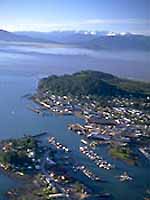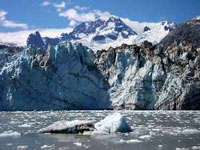Cruise Alaska for a Life Changing Journey

More than twice the size of Texas, Alaska is the largest state in the USA, a land of vast natural splendor, abundant wildlife and few people. It offers unique experiences such as walking in unspoiled wilderness, spectacular cruising through the fjords of the Inside Passage, and frontier towns rich in gold rush history.
Its sense of undiscovered wilderness and promise of adventure is still as strong today as it was in the past, and having attracted thousands of pioneers in search of gold, fur, fishing, logging and oil, this 'Last Frontier' today lures travelers in search of an unspoiled beauty and close encounters with nature.
The southeast epitomizes classic Alaskan scenery, with its fjords, mountains, forests and glaciers. Alaska is one of the top cruise destinations in the world and the main draw-card for visitors to this region is the lack of roads between towns and scenic wonders that make the waters of the Inside Passage a major marine highway ideal for ship travel. The number one attraction in the interior heartland is Denali National Park, an area of untamed magnificence that also encompasses North America's highest mountain, the snow-covered Mt McKinley.
Despite a reputation for high prices and inhospitable winters, millions of people have discovered a piece of America that is worth every dollar. Nowhere else can that frontier feeling be truly experienced, a place where wilderness surrounds every part of the Alaskan way of life.
The Inside Passage, Alaska

Shaped by the carving of massive glaciers millions of years ago, Southeast Alaska is an astounding region of deep fjords, glaciers, majestic mountains and forests. Known as the 'panhandle', it epitomises classic Alaskan scenery. Thousands of islands form a pristine protected waterway called the Inside Passage that is lined with many charming towns and small villages rich in history. About half of the tourists who travel to Alaska arrive on cruise ships that make their way through the islands of the Inside Passage to ports of call such as Ketchikan, Juneau, Sitka and Skagway.The area is home to the native cultures of Tlingit, Haida and Tshimshian Indians and the art of totem pole carving, traditional music and dance has been preserved especially in Ketchikan. Russian settlers have also left their legacy of icons and onion-domed churches, having been drawn to the region in search of fur; the region's promise of gold, salmon fishing and forests of timber attracted many profiteers. Today the business of tourism is an additional income-earner for many of the picturesque coastal communities.The history of the Gold Rush days is especially evident in the town of Skagway at the northern tip of the Inside Passage, once a lawless trading post serving the Klondike Gold Rush pioneers. Juneau is Alaska's attractive capital, with a bustling waterfront and a scenic mountain backdrop, and is the gateway to one of the country's more stunning regions, Glacier Bay National Park.With no roads connecting the towns the best way to travel is by the Alaska Marine Highway ferry that hops from town to town, or on one of the numerous and very popular cruises that ply the channels. The Alaska Marine Highway is a designated National Scenic Byway and is one of the most beautiful ways to explore Alaska. The deep waters and mild climate provide a prime habitat for whales, sea lions and porpoises, which can often be spotted from the deck. Between the picturesque fishing town of Petersburg and Russian-founded Wrangell is the spectacular Wrangell Narrows that is only 300ft (91m) wide and so shallow in places that the boat is forced into a slalom course of 46 turns to avoid grounding on the channel bottom. Frederick Sound is a prime whale sighting area.
Glacier Bay National Park
When the early explorers and pioneers of the 18th century sailed this way, Glacier Bay was hidden under a huge sheet of solid ice, more than 4,000ft (1,219m) thick and up to 20 miles (32km) wide. Today the branching 65-mile (105km) long fjord is the work of the fastest-receding glacier on earth, the melting ice of the Grand Pacific Glacier opening up a spectacular carved terrain of steep rock walls lining deepwater fjords. Sliding out of the mountains are 16 active glaciers that fill the sea with different shaped icebergs, creating the icy blue landscape that is world-renowned. At the head of the fjord is the massive ice wall of the Grand Pacific Glacier, slowly melting and sculpting the still-unfinished land as it backs away from the sea, a natural work of art in progress. An added attraction is the variety of aquatic life including humpback whales, sea otters, seals and porpoises, while bears, moose, mountain goats and many species of birds inhabit the land. This rugged landscape can only be accessed by boat or small plane as most of the park is made up of water. Because opportunities to see this huge wilderness are limited, facilities can be crowded, especially on the tour boats; activities are also expensive, and wildlife sightings cannot be guaranteed. Gustavus is the small settlement that services the park, but the park headquarters is at Bartlett Cove from where boats can be arranged or alternate means provided to enjoy the park experience. Kayaking or camping in the backcountry, ranger-led programs or walks, hiking and fishing are all available.


Worried about the climate? Although the assumption is that Alaska is a land of snow and sub-zero temperatures, the Alaskan climate is actually extremely varied, caused by the state's six different topographic regions. The far north is extremely dry and very cold, with Arctic conditions and temperatures average about -20°F (-29°C), and the ground at Point Barrow remains permanently frozen to a depth of 1,330 ft (405 m). Summer temperatures in the lowlands are surprisingly high, averaging in the 60s Fahrenheit (about 16°C), and they have been known to reach 90°F (32°C) and up. The southeast tends to be fairly moderate, with damp, rainy and sometimes mild conditions, with temperatures in July averaging 56°F (13°C) and temperatures in January averaging 30°F (-1°C) and the south and central areas tend to be similar, with slightly colder winter temperatures. Western Alaska tends to be rainy, while the Aleutian Islands in winter are damp and rainy, with fog. Heavy snows are common in the north and central regions of the state.
Interested in securing the lowest cruise rates for sailing an Alaska itinerary? Then consider reserving your cruise for May or September, the shoulder season for cruising Alaska. Best pricing and availability is the reward of early booking so don't delay, contact pat@incrediblejourney.net to reserve your 2009 Alaska cruise today!








